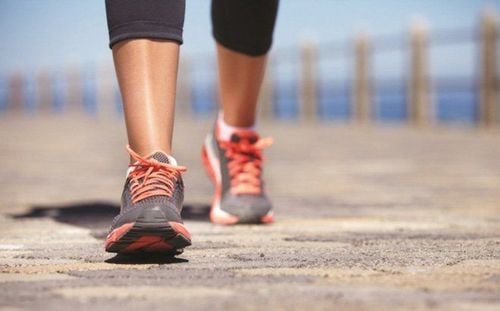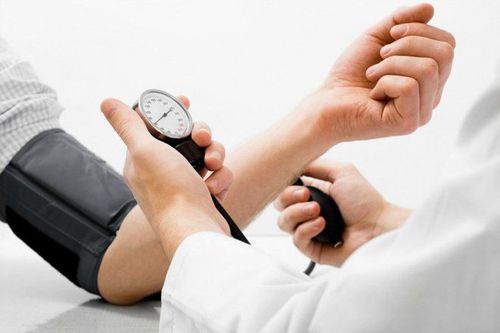This is an automatically translated article.
Exercise is part of a healthy lifestyle and part of their daily routine. So should exercise after injury? And how long should you wait to exercise after an injury? If you turn back too quickly, you risk re-injury or more harm. If you wait too long, then you are wasting time unnecessarily. The following article will give you a few tips for you to know how to return safely to exercise after injury.1. How long should you wait to exercise again after an injury?
Exercise is part of a healthy lifestyle, and many people make running, biking, playing sports or going to the gym part of their daily routine. Although this is a very good thing for our health, exercising can carry the risk of injury, especially for those who are just starting out. Even professional athletes often get injured. The question is how long should we wait to exercise after an injury? If you return to exercise too quickly, you have a high risk of re-injury. However, if we wait too long, we are wasting time unnecessarily.The question of when to exercise after an injury is directly related to the type of injury we have. Once the pain has subsided for a few days while we can still do a normal activity at work, home or school, it's time to consider getting back into exercise. This process can take days, weeks, or months.
It is important to continue to rest until the injury subsides during activities that do not involve exercise. Always start slow and remember to double-check your body parts for injury. If you return to your full workout immediately, you can easily re-injury. One rule of thumb is that the amount of time we need to take a break from exercise is exactly the amount of time we need to get back into exercise at peak intensity.

Cần tập các bài tập nhẹ nhàng trước khi trở về cường độ trước đây
2. Things to do to speed up the healing process
For many of us, patience is not their signature trait. While it's not good to return to exercise too soon, there are some things you can do to speed up the recovery process. Rest can be essential for healing, but don't just sit around and do nothing. Make the most of those uninjured parts of your body to do light daily tasks and continue working out the rest of your body in the meantime.Keeping the body healthy will aid in better healing of the injured area. A natural way to help reduce inflammation is to alternate hot and cold compresses. This method requires the practitioner to apply heat for 10 minutes on the injured area, then apply cold for 5 minutes.
Diet also plays a huge factor in how well the body heals, so always stick to a healthy diet during injury treatment. Massage – massaging the injured area is also beneficial. Finally, keep the injured area mobile by stretching or doing yoga exercises.
How to safely return to exercise after an injury
The most important tip for returning to exercise after an injury is to exercise slowly. While the body is recovering, we should change our mindset. Don't expect to immediately return to your pre-injury intensity. Reduce the amount of exercise when you first get back and listen to your body as you progress. If we try too hard with heavy exercises, we can re-injury and make the condition worse. The recovery time of trauma relapse cases will be much longer.
If the pain persists for hours after completing the exercise, the body is telling us that it is not ready. You will feel uncomfortable when you first return to exercise, but pain is never a good sign. A good way to start exercising is to gradually increase the intensity of exercises until your body gets used to them.
3. 6 steps to return to exercise after injury
When something happens like swelling, ankle pain or an unexpected injury, we can't exercise like we used to and don't know when we can return to training. That feeling is uncomfortable, especially for professional athletes.And while we'd love to get back to training, let's pause for a minute – injuries are no joke. They're the body's way of telling us that something is wrong, so we shouldn't start over right away. Instead, getting back into exercise should be done intelligently, as with any form of exercise, after a break from injury, you need to approach exercises slowly.
And even though we're all trying to get back to normal, and the wait feels so uncomfortable, ask yourself this:
Do you want to go back to training slowly, Painless to build healthy running or exercising exercises without other injuries? Or return to the same intensity as before the injury and run the risk of re-injury leading to further pain or another injury?
During recovery, it is important to listen to how your body feels. We need to trust our own bodies. It will let you know when we're ready to go back to doing certain things and when we're too hasty in our practice.
Other factors that will have a significant impact on our return to exercise include things like age, length of injury, and what we do to return to physical activity safely. With that said, here are 6 steps you can take to safely return to exercise after an injury:
3.1. Return to practice slowly
It's easy to get back to what we were doing before the injury, expert advice is not to go so fast! If we immediately return to intense training after the injury heals, we run the risk of making ourselves weaker, which means a risk of re-injury or other injuries.In addition, our bodies may have gotten used to inactivity or exercise for several weeks or more, so the muscles or joints have become much weaker. Return to exercise slowly after injury, and if you feel pain, you should stop exercising and consult a professional
3.2. Start with walking exercise
This is the body's most natural form of movement, and if you're injured, gentle walking is one of the best ways to keep other healthy organs working. Swimming is also a gentle and effective form of exercise. Ac-si-meter thrust will help the body reduce the pressure exerted on the injured area or organ.
Tập thể dục sau chấn thương nên bắt đầu với bài tập đi bộ đơn giản
3.3. Pay attention to the feeling of “pain”
While some people live by the motto "no pain, no benefits", but when it comes to trauma, we need to change this perspective. Pain is the body's signal to tell us that we've been working too hard. Rest and recovery are just as important as retraining. Give your body time to recover so it can return to normal.3.4. Workout core muscle groups
This may not be what many people think of when experiencing injuries, but performing exercises to improve balance will in turn help improve posture and strengthen core muscle groups - Essential for safe exercise. Without strong core muscle groups, we are at a higher risk of injury recurrence.3.5. Stick to a healthy diet and drink enough water
Eating well and staying hydrated are key to recovery. Food plays an important role in the body's recovery process and helps to keep joints strong again. Note to stay away from alcohol and any junk food during this time. Eating whole, natural foods and drinking plenty of water will help speed up the recovery process and help us get back to working out quickly.3.6. Consider seeking help from trauma specialists
A physical therapist or trauma doctor can provide a step-by-step recovery program tailored to each person and their needs, to help them get back to their favorite exercise quickly. and as safe as possible. Doctors will also be able to assess when we are ready to return to normal and will help ensure the injury does not recur. When it comes to health, fitness and lifestyle, it's important to listen to expert advice - that way we can be sure of getting back to work much faster and safer, just like what is desired.Injury in exercise and sports is something no one wants. However, injuries can still occur during exercise no matter how careful we are. In addition to treatment, it is also very important to return to exercises to be effective as well as ensure the highest safety. Experts have advised us not to return too quickly after an injury, to listen to our body and know when to stop. High-intensity exercise immediately after injury not only does not make the body stronger, but it can even cause the injury to return or encounter other injuries.
Please follow the website ( www.vinmec.com ) for more information on health care instructions, which we will update regularly.
Please dial HOTLINE for more information or register for an appointment HERE. Download MyVinmec app to make appointments faster and to manage your bookings easily.
Reference sources: ocpain.net, webmd.com, aulgoughphysio.com












